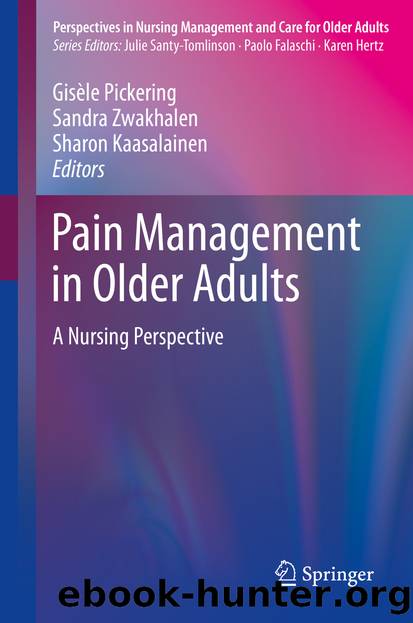Pain Management in Older Adults by Unknown

Author:Unknown
Language: eng
Format: epub
ISBN: 9783319716947
Publisher: Springer International Publishing
5.2 Pharmacological Changes with Aging
Pharmacokinetic and pharmacodynamic changes are associated with aging. A few reports suggest even greater significant pharmacokinetic and pharmacodynamic alterations in frail compared to healthy elderly persons (Shi et al. 2008).
5.2.1 Pharmacokinetic Changes
Absorption may be influenced by several factors including co-morbidities, medications slowing gastro-intestinal transit, chronic constipation, chronic laxative use, gastro-esophageal reflux, and dysphagia (Shi et al. 2008; Tumer et al. 1992). Furthermore, with transdermal absorption, significant inter-individual variability is often observed (Hammerlein et al. 1998).
Consequences of age-related changes in distribution are significant. Aging is associated with decreased lean mass, increased fat mass, and decreased total water volume; distribution of medications in the body is consequently altered (Hammerlein et al. 1998; Kinirons and Crome 1997). The distribution volume of hydrophilic medications (like morphine) is decreased, which increases plasmatic concentrations and requires lower dosing. Inversely, the distribution volume of lipophilic medications (like fentanyl) is increased, and this decreases their plasmatic concentrations and increases their half-life, often resulting in an accumulation of drugs (Hammerlein et al. 1998). Advanced age is also often associated with decreased serum albumin (Paolisso et al. 1995); this is more frequent in the presence of chronic disease or malnutrition, and results in an increased free fraction of the medication. These changes are, however, only clinically significant for medications with a protein binding higher than 90%, a small distribution volume, and a narrow therapeutic index (Grandison and Boudinot 2000).
Drug metabolism, liver mass, and hepatic blood flow decrease with age, which impairs drug clearance for flow-limited (high-clearance) drugs, with some authors suggesting 20–60% impairment of the intrinsic metabolic drug clearance (Butler and Begg 2008). The activity of phase I enzymatic reactions seems to be reduced, whereas activity of phase II enzymatic reactions is usually not modified (Schmucker 2001). Renal elimination, renal mass, and tubular secretion decrease significantly with age, with a 30–50% decrease in glomerular filtration at 80 years old. This may result in the accumulation of renally-excreted medications. Renal function and creatinine clearance may be estimated with the Cockroft-Gault formula, taking into account age, weight, serum creatinine, and gender (Cockcroft and Gault 1976). In older malnourished patients with decreased muscle mass, this formula overestimates creatinine clearance.
Download
This site does not store any files on its server. We only index and link to content provided by other sites. Please contact the content providers to delete copyright contents if any and email us, we'll remove relevant links or contents immediately.
Professional Troublemaker by Luvvie Ajayi Jones(29443)
Whiskey Words & a Shovel I by r.h. Sin(19198)
Rewire Your Anxious Brain by Catherine M. Pittman(18337)
Healthy Aging For Dummies by Brent Agin & Sharon Perkins RN(16934)
Cat's cradle by Kurt Vonnegut(14804)
Talking to Strangers by Malcolm Gladwell(12916)
The Art of Thinking Clearly by Rolf Dobelli(9951)
They Both Die at the End by Adam Silvera(9520)
The 5 Love Languages: The Secret to Love That Lasts by Gary Chapman(9315)
Doing It: Let's Talk About Sex... by Hannah Witton(9094)
The Compound Effect by Darren Hardy(8543)
Thirteen Reasons Why by Jay Asher(8490)
Goodbye, Things by Fumio Sasaki(8306)
Wonder by R.J. Palacio(8281)
Atomic Habits: Tiny Changes, Remarkable Results by James Clear(8066)
Becoming Supernatural by Dr. Joe Dispenza(7869)
Tools of Titans by Timothy Ferriss(7850)
Wonder by R. J. Palacio(7755)
Should I Stay or Should I Go? by Ramani Durvasula(7440)
